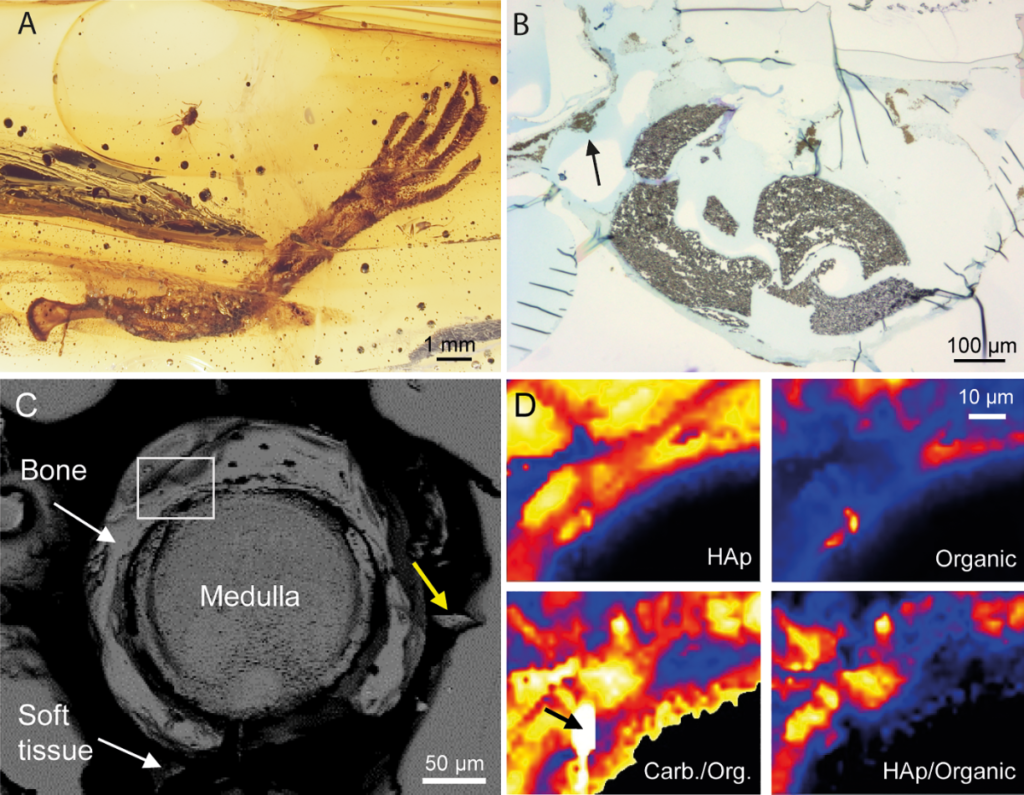A new paper describing the foot of a lizard preserved in amber broadens our understanding of the fossilization processes.

Image credits H. Jonas Barthel et al., (2020), PLOS One.
The tiny foot belonged to a lizard in the genus Anolis which became trapped in resin around 15 to 20 million years ago. It is very well preserved, with every detail of the limb visible under the microscope.
However, this dandy exterior hides a very different core: the bone inside this foot is heavily decomposed and chemically transformed, with very little of the original structures still present.
Foot for thought
“This is surprising, because we assumed that the surrounding amber largely protects the fossil from environmental influences” says Jonas Barthel, a doctoral student at the Institute for Geosciences at the University of Bonn and first author of the paper.
Every fossil begins with a rapid embedding in a protective material — in this case plant resin, which turned into amber over time. This layer of material protects the biological material from scavengers and microorganisms. After the animal is encased in a protective layer of material, its tissues start being gradually replaced by mineral compounds as pressure from sediments on top compresses everything — in essence, it starts becoming a rock.
“That’s the theory,” says Barthel. “How exactly fossilization proceeds is currently the subject of intensive scientific investigation.”
The fossil described in this study is pretty rare; it’s usually small organisms such as insects that get trapped in resin (which over time becomes amber), not vertebrates (which are larger). It was analyzed as part of a larger research project between the University of Bonn and the German Research Foundation centered on fossilization processes, which has been ongoing since 2018.
The whole piece of amber than encases the limb is about two cubic centimeters in size and was recovered from the Dominican Republic. It belongs to a genus that is still alive today and was housed at the Stuttgart State Museum of Natural History.
For the study, the team asked the Institute for Evolutionary Biology at the University of Bonn to cut the amber down into thin sections to allow for investigation of the fossil inside. The claws and toes inside the amber were very well preserved, the team reports, suggesting that resin had dripped onto the limb. Further investigations at the university’s Institute for Geosciences using micro-computer tomography revealed that the forefoot had been broken in two places. The area around one showed slight swelling, indicative of a fracture that happened prior to fossilization
“This is an indication that the lizard had perhaps been injured by a predator,” says Barthel.
The other fracture, however, seems to have formed after fossilization, and coincides with a tiny crack running through the amber.
Analysis of the bone inside showed that the mineral hydroxyapatite in its tissues had been transformed into fluoroapatite, implying that fluorine penetrated the tissues. Additionally, they found that the collagen in the bones has largely degraded now. In other words, although the fossil seems very well-preserved at first glance, very little of the original tissues remain intact. So far, the researchers were unable to detect complex molecules such as proteins in the fossil.
The team believes that the tiny crack in the amber allowed mineral-rich solutions to filter through into the leg and destroy the organic matter.
“We have to expect that at least in amber from the Dominican Republic, macromolecules are no longer detectable,” says the supervisor of the study, Prof. Dr. Jes Rust from the Institute for Geosciences.
It was not possible to detect more complex molecules such as proteins, but final analyses are still pending. The degradation processes in this amber deposit are therefore very advanced, and there is very little left of the original substance.
Amber is generally considered to be an ideal preservative, as a fully-encased fossil will be completely isolated from the environment. However, in the case of this fossil, the team was surprised to see that the amber might have actually promoted the degradation of soft tissues. Acids in the original tree resin have probably reacted with apatite in the bones in a process similar to tooth decay, the researchers conclude.
The paper “Fluoridation of a lizard bone embedded in Dominican amber suggests open-system behavior” has been published in the journal PLOS One.


